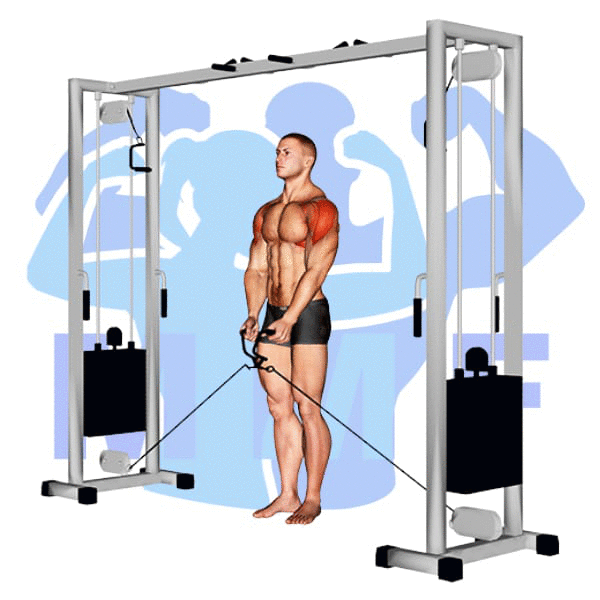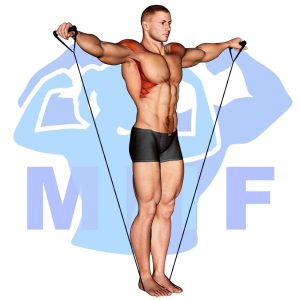Are you tired of feeling like your shoulders just won’t cooperate during your workouts? Does the thought of doing lateral cable raises make you cringe? Don’t worry, we’ve all been there. Oftentimes, shoulder pain and discomfort during this exercise can be attributed to a lack of proper form or muscle activation. But fear not, with a few simple tweaks and exercises, you can be on your way to performing lateral cable raises pain-free and with proper form. In this post, we’ll be discussing the common mistakes people make when performing lateral cable raises and the exercises you can do to alleviate shoulder pain and boost muscle activation.
Lateral Cable Raises Summary
- Primary Muscles: Supraspinatus
- Secondary Muscles: Deltoid – Lateral, Deltoid – Anterior, Serratus Anterior, Supraspinatus, Trapezius – Lower, and Trapezius – Middle
- Equipment: Cable Machine with Two Single D-Handles
- Mechanics Type: Isolated
- Force: Pull
- Utility: Auxiliary

Lateral Cable Raises Instructions
- Start with setting up low pulleys to each side
- Grab the right handle with your left hand and the left handle with your right hand.
- Now, as you stand upright bend your elbows slightly, then raise your arms to your sides until your elbows are shoulder height.
- Finally, allow the pulley to lower your arms back to the center and repeat.
Video Tutorial
Lateral Cable Raises Muscles
Target (Agonist)
- Supraspinatus
Synergists
Dynamic Stabilizers
- None
Stabilizers
- No Significant Stabilizers
Antagonist Stabilizers
- None

Benefits of Lateral Cable Raises
Performing lateral cable raises is an effective way to target and strengthen the Supraspinatus muscle, which is a key component of the rotator cuff. This exercise helps improve shoulder stability and mobility, as well as reduce the risk of shoulder injuries. It can also help with shoulder pain and discomfort due to rotator cuff tendonitis or impingement. Additionally, lateral cable raises can help improve posture and strengthen the shoulder girdle, which is important for overall shoulder health.
Tips for Performing Lateral Cable Raises
Your at the right place if you’re trying to enhance your lateral cable raises execution. Using these suggestions can enable you to take full advantage of this amazing workout. You will develop your shoulders muscles, and even reduce your chances of developing an injury. Let’s begin and take a look at how these tips will benefit you.
- Start slow: Start with lighter weights and focus on form and technique before attempting heavier weights. This will help you maximize your workout and reduce the chance of injury.
- Use proper posture: Keep your back straight and chest forward while performing the exercise to ensure correct form. This will help you engage the correct muscles and get the most out of your workout.
- Take breaks: Take breaks between sets so that your muscles can recover and you can focus on form and technique for each set. This will help you stay focused and prevent fatigue.
Benefits and Tips Video
Frequent Mistakes To Avoid
Avoiding common mistakes can be the distinction between a successful training session and a painful injury when executing lateral cable raises. Additionally, achieving optimal results from this exercise requires proper form, and avoiding make any common mistakes can help you to perform the exercise better and achieve optimal results. Don’t worry, though, it’s not at all difficult as it might appear. You can execute the exercise safely and efficiently by avoiding the mistakes to prevent and by executing the correct steps. So it is time for you to optimize the impact of this exercise and enjoy the benefits of a successful workout.
- Not using proper form: It is important to ensure that the back is kept straight and the arms are not bent throughout the exercise. This helps to ensure that the correct muscles are being worked and that the risk of injury is minimized.
- Not using enough weight: Lateral cable raises can be done with light weights, but it is important to challenge yourself with heavier weights in order to achieve the desired results.
- Not doing enough repetitions: To get the most out of this exercise, it is important to do a minimum of 10-15 repetitions per set. This will help to ensure that the desired muscles are being worked and that there are no muscle imbalances.
Find More Cable Exercises Here
Variations and Complementary Exercises
If you are looking to mix up your workout routine and incorporate a few different exercises that work the same muscles as lateral cable raises, look no further! Below is a list of variations, complementary, or alternative exercises that you can use to target the same muscles.
Incline Dumbbell One Arm Lateral Raise

The Incline Dumbbell One Arm Lateral Raise is a great complementary or alternative exercise for the Lateral Cable Raise. This exercise targets the same muscles, but does so in a different way. It requires you to use one arm at a time, making it a great way to target the deltoid muscles. This exercise also activates the stabilizing muscles of the shoulder, which can help to reduce the risk of injury. The incline angle makes this exercise more challenging and it also helps to target the rear deltoids, providing an extra challenge to the workout.
Incline Dumbbell Raise

The Incline Dumbbell Raise is a great complementary or alternative exercise to the Lateral Cable Raises. This exercise works the same muscles as the lateral cable raises, with the added benefit of engaging the upper chest and shoulders. To perform the Incline Dumbbell Raise, you will need a bench set to an incline angle. Begin by holding a pair of dumbbells in each hand at your sides and slowly lift them up until they reach shoulder height. Be sure to keep your elbows slightly bent throughout the exercise and be mindful of your form. The Incline Dumbbell Raise is a great exercise for targeting and strengthening the shoulders and upper chest muscles.
Incline Dumbbell Rear Lateral Raise

The Incline Dumbbell Rear Lateral Raise is a great complementary or alternative exercise to the Lateral Cable Raise. It targets the same muscle group, but works them from a different angle. This exercise can be performed by holding a dumbbell in each hand and keeping the arms straight as you raise them out to the side. The incline of the back helps to target the shoulder muscles more effectively and also helps to reduce strain on the lower back. You can adjust the incline of the back and adjust the weight of the dumbbells as needed to get the desired results.
Check Out These Top Cable Exercises
Incline Dumbbell Rotating Lateral Raise

The Incline Dumbbell Rotating Lateral Raise is a great complementary or alternative exercise to the Lateral Cable Raises. It helps to build shoulder strength and stability, while also adding in an element of rotational power. It is performed in a standing position with one arm bent at 90 degrees and the other arm extended straight out. The dumbbell is then rotated to the side at a slightly upward angle, while keeping the elbow slightly bent. This exercise can be done with both arms simultaneously or alternating arms for more of a challenge. It is a great way to build shoulder strength and stability while also targeting the rotator cuff muscles.
Incline Dumbbell Single Arm Rear Lateral Raise

The Incline Dumbbell Single Arm Rear Lateral Raise is a great complementary or alternative exercise for the Lateral Cable Raises. This exercise works the same muscles as the Lateral Cable Raises, but with a slightly different focus. By performing the exercise in an incline position, you are able to target the rear deltoids and the upper back muscles more effectively. Furthermore, by using dumbbells instead of cables, you can increase the range of motion and challenge yourself to use a heavier weight. The Incline Dumbbell Single Arm Rear Lateral Raise can also be performed standing up or sitting on an incline bench.
Lateral Raises With Bands

Lateral Raises With Bands are an excellent complementary or alternative exercise for the Lateral Cable Raises. This exercise is done with a resistance band, either anchored to the floor or held in the hands of a partner, and is performed by raising your arms out to the side and up in an arcing motion. This movement helps to target and strengthen the shoulder muscles, as well as the upper chest and back muscles. Additionally, by using a band rather than a cable, this exercise is easier on the joints, making it ideal for those with joint pain or injury.
Find More Shoulders Exercises Here
Opposing Complementary Exercises
To maximize the benefits of Lateral Cable Raises, it is important to engage opposing muscle groups as well. For this reason, it is beneficial to supplement this exercise with the following exercises which work the opposite muscles:
V Bar Lateral Pulldown

The V Bar Lateral Pulldown is a great complement to the exercise Lateral Cable Raises. This exercise targets the Latissimus Dorsi, the opposing muscle group to the one used for Lateral Cable Raises, which works the Deltoids. By incorporating the V Bar Lateral Pulldown into your routine, you will be able to hit both muscle groups and achieve a well-balanced workout. The V Bar Lateral Pulldown is a great way to target the Latissimus Dorsi, as it works the muscles in a slightly different way than Lateral Cable Raises. This helps to ensure a full-body workout that will benefit your overall health and fitness.
Weighted Pull Up

Weighted Pull Ups are a great complement to Lateral Cable Raises as they use the opposing muscle group. Pull Ups target the back, shoulders, biceps and chest muscles while Lateral Cable Raises target the shoulders, deltoids and triceps. By doing both exercises together, you can develop a well-rounded strength in the upper body. Weighted Pull Ups also help to increase your grip strength and add extra challenge to your workout. Both exercises can be done with added resistance, such as weights or bands, which makes them even more effective.
Wide Grip Pull Up

Wide Grip Pull Ups are a great exercise for targeting the back muscles, particularly the lats. This exercise is complementary to Lateral Cable Raises as it works the opposing muscle group. Wide Grip Pull Ups will help to strengthen the lats while Lateral Cable Raises work the deltoids. When both exercises are performed together, they can help to create balance between the two muscle groups, leading to better posture and overall strength.
Elevate Your Shoulder Workout with Lateral Cable Raises
If you’re looking to elevate your shoulder workout, lateral cable raises are the perfect exercise to add to your routine. These raises target the lateral deltoid muscle, which is responsible for lifting the arm away from the body. Using a cable machine adds resistance and can help increase the muscle’s engagement throughout the movement. Be sure to use proper form and control the weight throughout the exercise by keeping the movement slow and controlled. Remember to breathe and keep the shoulders relaxed, focusing on using the lateral deltoids to lift the weights.
References: Wikipedia | ExRx.net | PubMed.gov | Comprehensive List of Shoulders Cable Exercises




